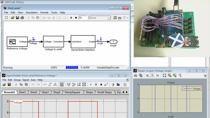How to Do Data Cleaning in MATLAB
Data analysis is only as good as the data used. Raw data usually has missing values and outliers that could lead to incorrect analysis. Data Cleaning is an iterative process and is often time-consuming. The Data Cleaner app in MATLAB® provides an interactive tool for completing data cleaning workflows more quickly and without needing to write code directly. Learn how you can use the Data Cleaner app to clean your data using simple cleaning steps and prepare it for analysis and model development.
Published: 1 Dec 2022




